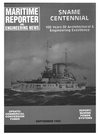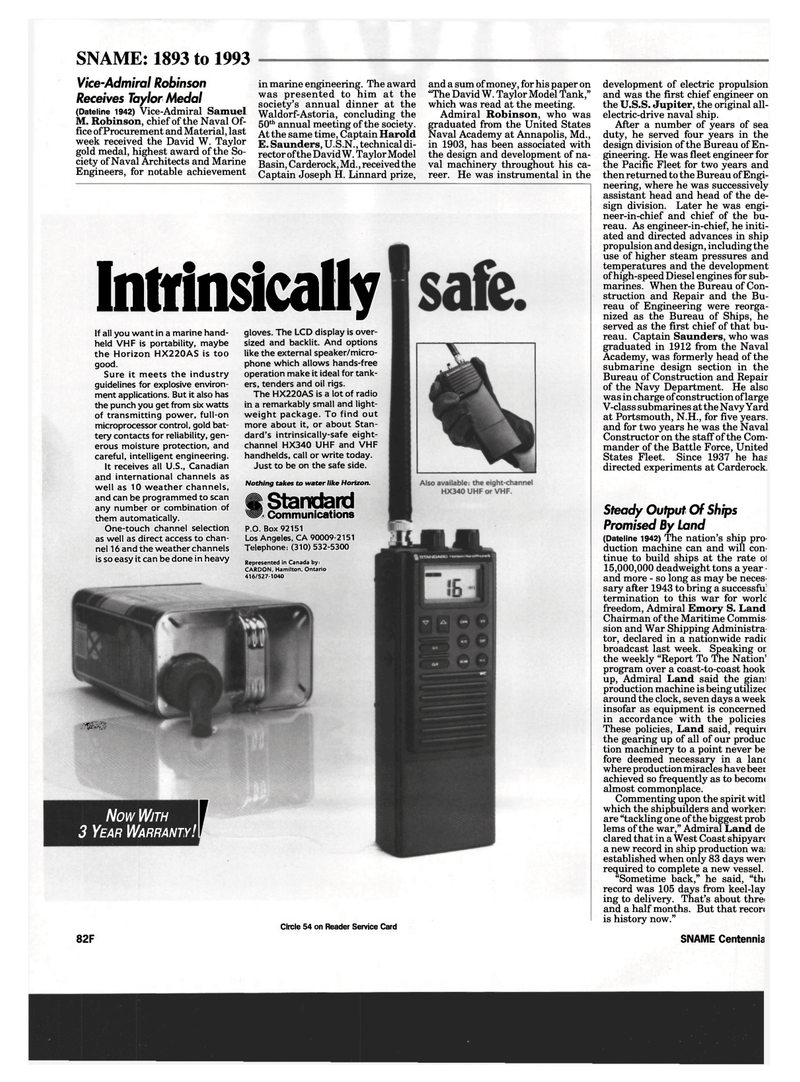
Page 86: of Maritime Reporter Magazine (September 1993)
Read this page in Pdf, Flash or Html5 edition of September 1993 Maritime Reporter Magazine
SNAME: 1893 to 1993
Vice-Admiral Robinson
Receives Taylor Medal (Dateline 1942) Vice-Admiral Samuel
M. Robinson, chief of the Naval Of- fice of Procurement and Material, last week received the David W. Taylor gold medal, highest award of the So- ciety of Naval Architects and Marine
Engineers, for notable achievement in marine engineering. The award was presented to him at the society's annual dinner at the
Waldorf-Astoria, concluding the 50th annual meeting of the society.
At the same time, Captain Harold
E. Saunders, U.S.N., technical di- rector of the David W. Taylor Model
Basin, Carderock, Md., received the
Captain Joseph H. Linnard prize, and a sum of money, for his paper on "The David W. Taylor Model Tank," which was read at the meeting.
Admiral Robinson, who was graduated from the United States
Naval Academy at Annapolis, Md., in 1903, has been associated with the design and development of na- val machinery throughout his ca- reer. He was instrumental in the development of electric propulsion and was the first chief engineer on the U.S.S. Jupiter, the original all- electric-drive naval ship.
After a number of years of sea duty, he served four years in the design division of the Bureau of En- gineering. He was fleet engineer for the Pacific Fleet for two years and then returned to the Bureau of Engi- neering, where he was successively assistant head and head of the de- sign division. Later he was engi- neer-in-chief and chief of the bu- reau. As engineer-in-chief, he initi- ated and directed advances in ship propulsion and design, including the use of higher steam pressures and temperatures and the development of high-speed Diesel engines for sub- marines. When the Bureau of Con- struction and Repair and the Bu- reau of Engineering were reorga- nized as the Bureau of Ships, he served as the first chief of that bu- reau. Captain Saunders, who was graduated in 1912 from the Naval
Academy, was formerly head of the submarine design section in the
Bureau of Construction and Repair of the Navy Department. He also was in charge of construction of large
V-class submarines at the Navy Yard at Portsmouth, N.H., for five years, and for two years he was the Naval
Constructor on the staff of the Com- mander of the Battle Force, United
States Fleet. Since 1937 he has directed experiments at Carderock.
Steady Output Of Ships
Promised By Land (Dateline 1942) The nation's ship pro- duction machine can and will con- tinue to build ships at the rate ol 15,000,000 deadweight tons a year • and more - so long as may be neces- sary after 1943 to bring a successful termination to this war for worlc freedom, Admiral Emory S. Land
Chairman of the Maritime Commis- sion and War Shipping Administra- tor, declared in a nationwide radic broadcast last week. Speaking or the weekly "Report To The Nation' program over a coast-to-coast hook up, Admiral Land said the giarn production machine is being utilizec around the clock, seven days a week insofar as equipment is concerned in accordance with the policies
These policies, Land said, requin the gearing up of all of our produc tion machinery to a point never be fore deemed necessary in a lane where production miracles have beei achieved so frequently as to becom< almost commonplace.
Commenting upon the spirit witl which the shipbuilders and worker; are "tackling one of the biggest prob lems of the war," Admiral Land de clared that in a West Coast shipyarc a new record in ship production wai established when only 83 days weri required to complete a new vessel. "Sometime back," he said, "thi record was 105 days from keel-lay ing to delivery. That's about threi and a half months. But that recori is history now."
Intrinsically
If all you want in a marine hand- held VHF is portability, maybe the Horizon HX220AS is too good.
Sure it meets the industry guidelines for explosive environ- ment applications. But it also has the punch you get from six watts of transmitting power, full-on microprocessor control, gold bat- tery contacts for reliability, gen- erous moisture protection, and careful, intelligent engineering.
It receives all U.S., Canadian and international channels as well as 10 weather channels, and can be programmed to scan any number or combination of them automatically.
One-touch channel selection as well as direct access to chan- nel 16 and the weather channels is so easy it can be done in heavy gloves. The LCD display is over- sized and backlit. And options like the external speaker/micro- phone which allows hands-free operation make it ideal for tank- ers, tenders and oil rigs.
The HX220AS is a lot of radio in a remarkably small and light- weight package. To find out more about it, or about Stan- dard's intrinsically-safe eight- channel HX340 UHF and VHF handhelds, call or write today.
Just to be on the safe side.
Nothing takes to water like Horizon. §Standard s Communications
P.O. Box 92151
Los Angeles, CA 90009-2151
Telephone: (310) 532-5300
Represented in Canada by:
CARDON. Hamilton. Ontario 416/527-1040 fljjiiil-
Now WITH 3 YEAR WARRANTY! !
Circle 54 on Reader Service Card 82F SNAME Centennia

 85
85

 87
87
